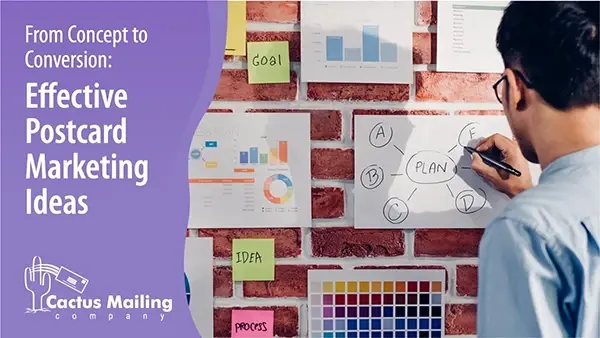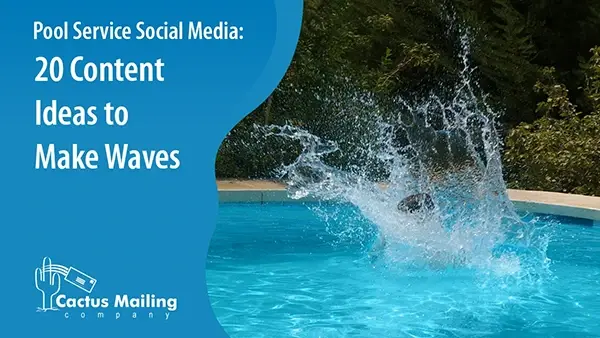We Are Here to Help!
What to Expect from Us:
No Pressure, Just Service!
Get no obligation pricing details and strategies that will work for your business.
Postcard marketing has become one of the best ways to attract new customers and build your business. In fact, a single, custom-designed direct mail campaign that is printed and sent to a group of selected recipients doesn't just boast the best response rate of all marketing channels but also yields the highest return on investment (ROI).
Now, in order to make your materials stand out, you need to consider their design. Colors, fonts, images, and a compelling CTA make all the difference when it comes to direct mail campaigns.
This article will show you the most effective design for your marketing postcards and how to do everything from planning, setting goals, and targeting potential customers to picking the best elements to make sure your direct mail marketing works. So, let's get started!
The Effectiveness of Direct Mail and Postcard Campaigns
Across all industries, digital marketing methods continue to gather momentum. Among them are, for example, search engine optimization, social media advertising, and email campaigns. These are all effective ways to bring attention to your business, but did you know that the most overlooked marketing tool is actually also the one with the highest ROI?
That's right. On average, advertising mail delivers a $14 return for every $1 spent. This rate is significantly higher than that of any other marketing strategy. But that's not all. Consumer advertising mail is generating about $30 billion a year (yes, that's billion with a b!). And, if that's not enough to convince you direct mail is a good idea, did you know that the response rate for this marketing method is 60%? Also much, much higher than any other method and well above anything digital.
So, before we move on to tips and tricks for designing the most compelling campaigns, let's quickly summarize the benefits of direct mail (in particular, postcards for prospective buyers):
- Many more people see direct mail. In other words, 60% of recipients open the mail, and 40% of them read it. Again, much better numbers than other marketing strategies, such as email campaigns, which are often deleted without a second thought.
- Direct mail also allows you to target your reach. Specifically, you can choose the demographics or geographic areas for better results.
- Physical mail pieces can make a personal and lasting impression. Unlike digital marketing, recipients can hold, read, and interact with printed materials, creating a more personal and memorable connection.
- Direct mail can complement your overall marketing strategy because you can integrate it with other marketing efforts, such as social media, email campaigns, and online advertising - reinforcing your message and reaching a much wider audience.
Before You Design Your Postcard Campaign
The first step when jumping into the world of direct marketing postcards is planning. We know it's tempting to just pick a postcard template and start mailing, but if you want your campaign to be successful, you need to make sure your materials will be received by the right people.
When we talk about planning, we specifically refer to targeting. Targeted mailings are more cost-effective than sending postcards to a broad, unfiltered audience because when you focus on specific demographics, geographic areas, or buyer/seller personas, you minimize the cost of printing and postage.
More importantly, though, when your postcards reach individuals who are more likely to be interested in your services or products, you simply increase the chances of a positive response. In other words, targeted recipients will be more likely to read your postcard, visit your website, or contact you for inquiries.
So, before you even design your postcards, start by clarifying your campaign's objectives. For example, suppose you are sending real estate postcards for your real estate business. Are you looking to attract first-time homebuyers, luxury property buyers, sellers in a specific neighborhood, or another segment of the real estate market?
Don't forget to also determine the demographic attributes of your ideal clients, such as age, income level, occupation, family status, and lifestyle preferences. Continuing with our example, if you're targeting retirees in your real estate postcard templates, your demographics will differ from those targeting young professionals (your just-listed postcards, for example, might feature bungalows or smaller properties).
Best Postcard Marketing Campaign Ideas
Alright; we have covered the benefits of direct mail and gone through the importance of targeting your recipients to maximize your reach. Now, let's talk about some good ideas to make sure your postcards stand out. We'll use the example of real estate postcard design, but these tips can be applied to any industry.
Tip #1: Design Postcards By Marketing Goal
A good starting point for designing your postcards is to use your marketing goal as a guide. For example, here are some common goals your business might be considering:
- You want to increase your sales by offering a limited-time discount.
- You want to introduce customers to a new service or product.
- You want to bring more people to your business as a whole.
- You want to generate leads that are qualified.
- You want to invite existing customers to buy from you again.
It's best to start with a broader goal and then think in terms of specific achievements, as this will help you determine the general layout of your postcard. For example, if you are sending real estate postcards, you can determine a goal of making one property sale. So, you can then use that goal to calculate your desired investment amount.
Tip #2: Target Audience by Demographic Data
We have talked about targeting above, but let's see a specific tip that can be particularly good for real estate agents looking to make a real impact on prospective clients.
Suppose you want to create listed real estate postcards. Your next step should be to survey the local real estate market and consider who your prospective buyers are. You can, for instance, think in terms of:
- Age
- Gender
- Income
- Location
- Marital Status
- Whether they have children
Or also expand into more specific categories any successful real estate agent should be fairly familiar with, such as:
- Whether the person owns or rents their house.
- Someone's occupation, industry, or business.
- An individual's annual revenue.
One way to target before you start mailing postcards is to use the geographic area. This could be a specific neighborhood, ZIP code, city, or even a broader region. These areas can, for example, help you segment your target audience based on property type (single-family homes, condos, commercial properties) or buyer/seller behavior (first-time buyers, repeat clients, investors).

Tip #3: Use a Compelling Offer And/Or Coupon
One of the things you should think about when designing postcards is whether there's a way to make people keep your materials around for a bit longer. After all, they might not be ready to contact you today, but you want to give them the chance to do so in the future.
A good way to do this is by including a promotion or discount code, in fact 53% of consumers in a 2024 study stated they were mostly likely to use an offer they received via direct mail.
Continuing with our real estate example, you can, for instance, offer money to people who tell you about a property owner who wants to sell their house.
Here are some other ideas you can use on your real estate postcards:
- First-time homebuyer discount: You can offer a special discount or rebate to first-time homebuyers who engage in your services. You can especially emphasize the cost-saving aspect of working with you.
- Home evaluation coupon: You can also provide recipients with a coupon for a free home evaluation. Highlight the value of knowing the current market value of their property.
- Seller's commission discount: You can offer a reduced commission rate for sellers who list their properties with you. If you do this, make sure to emphasize potential cost savings.
- Move-in ready package: You can create a "Move-In Ready" package coupon for buyers and include services such as home inspections, cleaning services, or a handyman's visit at a discounted rate when they purchase a home through you.
- Referral program: Lastly, you can encourage recipients to refer friends or family to your real estate services by providing a referral coupon. Offer a discount or gift when a referral results in a successful transaction!
Using coupons or discounts in direct mail postcards can be a highly effective way to encourage recipients to take action. And, talking about action, let's see our next essential tip: CTAs.
Tip #4: Use A Strong Call To Action (CTA)
Whether you want potential customers to contact you about your services, visit your website, or attend an open house event, there is one key element you need to carefully consider, and that is the Call-To-Action (commonly known as CTA).
So, what is exactly a CTA? It is a specific instruction or prompt designed to encourage the recipient of a marketing message (in this case, a postcard) to take a particular action. CTAs are typically used to guide potential customers or leads through the sales or conversion funnel, so they are critical elements in various marketing materials, including direct mail.
Ultimately, the purpose of a CTA is to make it clear what action you want your postcard audience to take next. Let's see some common examples of CTAs:
- "Buy Now" or "Shop Now": This type of Call-To-Action encourages people to make a purchase. The use of the word "now" creates a sense of urgency, which has been proven to maximize conversions.
- "Sign Up" or "Subscribe": These phrases and words prompt the audience to join a mailing list, subscribe to a service, or create an account. The biggest advantage of having subscribers is that you don't need to spend as much time acquiring new customers. Plus, they tend to generate a sense of community.
- "Request a Quote" or "Get Started": These CTAs invite the audience to seek more information or begin a consultation or application process. They are also considered less invasive and more user-friendly, as they put little pressure on the potential customer.
- "Learn More" or "Read More": These phrases lead the audience to additional content or information. They are also low-pressure ways of motivating someone to understand your services or products better.
- "Call Now" or "Contact Us": These CTAs urge the audience to get in touch via phone or email. They are a bit more involved but can be paired with actual phone numbers or email addresses so they are good at motivating people to reach out.
- "Download Now" or "Get the Free Guide": If you are offering downloadable resources, such as ebooks, whitepapers, or templates, these CTAs are a good way of inviting people to engage with more marketing materials.
- "Share" or "Follow Us": Lastly, these CTAs encourage social media engagement by asking the audience to share content or follow the brand on social platforms.
You can come up with your own Call-To-Actions. All you need to keep in mind is that the most effective CTAs are typically brief, clear, action-oriented, and placed prominently within the marketing material. They should also try to convey a sense of urgency or value to motivate the audience to act.
Tip #5: Add Social Proof
One of the things people tend to connect with the most when they are looking to make a purchase is testimonials. In fact, studies have shown that 96% of people at least occasionally read reviews when they are browsing local businesses, and 95% have said that reviews influence their purchasing decision.
As you can see, social proof is essential to boost the chances of someone reaching out to you after they've seen your marketing materials - no matter their format. However, you'd be surprised to see how many marketers simply do not use them!
In some cases, the reason is that postcards don't have as much space as other marketing materials, like brochures. However, you don't need much to show some quotes from customers. You can, for instance, use star ratings or just point to your TrustPilot score. Whenever you can, though, you should consider adding pictures of the customers giving the testimonials. Potential clients can connect much more easily if they see a friendly face.
Tip #6: Consider Vertical Postcards
An easy way to make your postcard design stand out is to use a slightly unexpected orientation. Using bright colors, nice fonts, and powerful images are all essential considerations, but using a vertical layout is something that can instantly set your printed materials apart. After all, the majority of postcards people receive (including holiday real estate postcards, FSBO real estate postcards, and most other marketing materials) are horizontal.
Additionally, a vertical orientation can allow for more creative and visually striking designs. For example, you can use this format to showcase property photos, graphics, and other visuals more effectively and guide recipients through a narrative, highlighting the features and benefits of a property or explaining your real estate services.
We have talked a little about the importance of a Call-To-Action. With a vertical postcard design, you can strategically place your CTA at the bottom, making it more prominent and ensuring it's one of the last things recipients see before deciding to take action.
Tip #7: Use A/B Testing
A/B testing, also known as split testing, is a valuable strategy used by various channels and across many different industries. The principle is quite straightforward: You present your audience with either one design or another (this is generally picked at random) and then compare how well each does.
Suppose, for example, you are using A/B testing on a website. You would then show different users Page A or Page B (let's say these are product pages). Then, you see how many people clicked on "Buy Now". If Page A received more clicks, then you know it's a more effective way of promoting a purchase.
You can do A/B testing on postcards and other printed marketing materials, too. You can, for instance, consider conducting small-scale test campaigns to assess the response rates of different target groups or designs. One of the main advantages of this approach is that you can use the results to fine-tune your targeting strategy for larger campaigns.
Here are a few more specific tips to plan your A/B test campaigns:
- Select a variable to test: First, identify a specific element of your direct mail postcards that you want to test. Common elements to test include the headline, offer, call to action (CTA), design layout, images, colors, font styles, or even the size of the postcard.
- Create two versions: Then, develop two distinct versions of your postcard, keeping everything the same except for the variable you're testing. For example, if you're seeing which headline does better, you can create two versions of the postcard with different headlines but identical in everything else.
- Randomly split your audience: Divide your mailing list into two groups randomly. Group A will receive version A of the postcard, while Group B will receive version B.
- Track and measure: You should also implement a tracking system to monitor the response rates and effectiveness of both versions of the postcard. This may involve using unique phone numbers, custom URLs, or coupon codes specific to each version.
- Analyze the results: Lastly, compare the response rates and other relevant metrics for both versions of the postcard. Determine which version performed better based on your campaign goals... and implement the changes!
Tip #8: Repeat Testing
One important thing to remember is that your target audience may evolve over time, so it's essential to adapt your targeting strategy accordingly.
One way to do this is by regularly testing, reviewing your results, and adjusting your target audience to improve your campaign's effectiveness. Over time, you should gain a deeper understanding of what resonates with your target audience. You can then use this knowledge to create more effective postcards and improve your overall marketing strategy.
For example, A/B testing enables you to make data-driven decisions and refine your direct mail campaigns for better results. But it's only by systematically testing and optimizing various elements of your postcards that you can increase their effectiveness in attracting leads, converting prospects, and achieving your real estate marketing goals.
So, you should think of any testing as an ongoing process. For better results, continue to try different elements and strategies to refine your direct mail campaigns continually.
Conclusion
Direct mail and marketing postcards, in particular, are excellent ways to find new customers or keep your existing ones engaged. As we've covered in this article, they offer several advantages when compared to other marketing strategies, including impressive ROI and response rates. Plus, well-designed postcards are tangible and memorable!
You can plan your campaign on your own, but if you're unsure how to target your audience or design your card, why not trust an expert? Cactus Mailing has more than 21 years of experience and has assisted over 23,000 businesses in printing and mailing over 500 postcards.
We can help you design your campaign, print it, and mail it to recipients in bulk or in smaller quantities. So, why not try our Free Postcard Design special offer? Contact us today to learn more.

 Mike Ryan: Oct 19, 2023
Mike Ryan: Oct 19, 2023



 Nick Ryan
Nick Ryan
 Cactus Mail Team
Cactus Mail Team